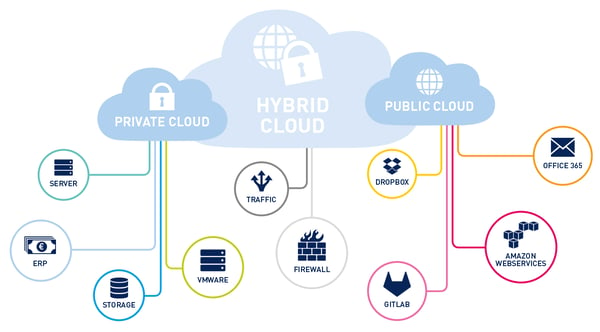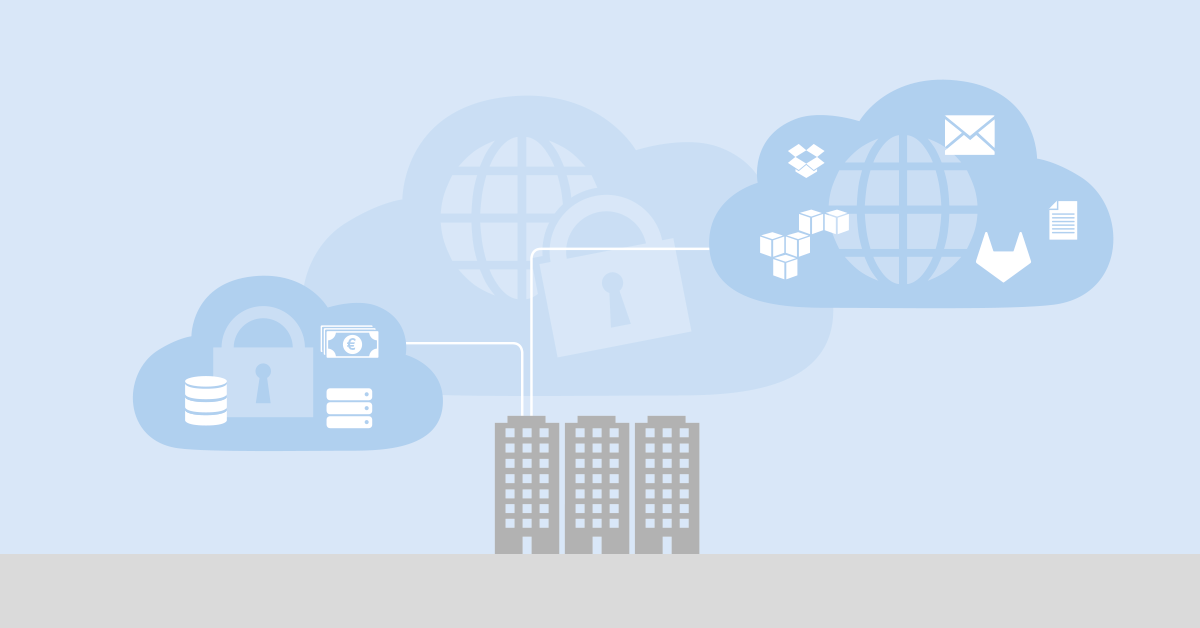Hybrid cloud is one of the hottest topics in IT at the moment. The term “hybrid cloud” refers to the use of both a private cloud and a public cloud in parallel, or a connection between the two. As with many IT trend topics, there’s no standard concept or generally-accepted definition of the term “hybrid cloud”. Rather, this is a concept with multiple interpretations.
1. Hybrid Cloud Models
However, there are two basic models and motivations for a hybrid cloud that are common to all:
Scaling
A company operates its own cloud, a so-called “private cloud”. If demand for computing resources temporarily increases or spikes, then the company scales its resources by outsourcing some of the processing to a public cloud. This lets the company scale its data center to handle normal traffic load rather than needing to invest in enough resources to handle peak loads. When demand drops down again, the company simply stops using the additional public cloud resources.
Security
To benefit from the benefits of the cloud without needing to outsource sensitive data and processes, a company can keep security-relevant applications and data in their own private cloud, and can outsource uncritical processes to public cloud services.
For both of these, integration of the private with the public cloud and the design of workflows is critical.
2. Ensuring Availability
No matter why a hybrid cloud design is being introduced, the setup, configuration and ongoing control mechanisms are critically important. The main value of each cloud type is found in lag-free availability of those cloud services. To ensure this availability, continuous and comprehensive monitoring of all of the cloud components involved is of fundamental importance, both in the public cloud and in the private cloud, and, of course, in the underlying network infrastructure, which is ultimately the basic prerequisite for data and process transfer between private and public cloud.
The possibilities for monitoring the public cloud are relatively limited. You’re limited to tools from the cloud vendor, such as Amazon CloudWatch, to monitor the overall performance of the cloud services. In addition, you can monitor the performance of the applications used. You do not have access to the underlying hardware. However, you do have an SLA for the various options offered by the providers.
This is usually not the case with a private cloud and the network. If you operate them yourself, you are also responsible for availability and performance and should set up an appropriate monitoring. The requirements for monitoring private cloud and conventional IT infrastructure have significant overlap. As such, it’s sensible to use a central solution for monitoring both public and private cloud and the network. What needs to be done, and where do you need to be careful?
3. Monitoring the Public Cloud
As already mentioned, the possibilities here are limited: You don’t have access to, nor should you care about the underlying hardware. You also can’t directly monitor the cloud application. However, your monitoring solution should support vendor tools such as Amazon CloudWatch out-of-the-box. It’s also advantageous when pre-defined queries are available for the most important cloud offerings such as Dropbox, GitLab or Google Drive. However, hardly any monitoring software can deliver all the required features. So, it’s important to have a documented API available, which can be used to integrate tools from the less widely-used cloud providers without too much effort.
4. Private Cloud and Network
The private cloud runs on your hardware and is reached via your network. It is part of your IT infrastructure and is therefore completely your responsibility. However, your network or infrastructure also has importance with regards to the public cloud, because you must ensure that your colleagues have secure and high-performance access to the public cloud at all times. It’s essential to monitor the network performance, i.e. the solution must cover the usual protocols such as SNMP, flow and packet sniffing, in order to identify traffic and bottlenecks. It must be able to monitor virtualization platforms and standard applications, such as databases or Web servers. Of course, here too, an API is very important, since your private cloud, network devices and applications are just as important as in the public cloud, but they may be non-standard and thus cannot be supported out-of-the-box.

Hardware, virtual layers, applications, storage, services: Hybrid clouds are complex.
5. General Requirements
In addition to the special features for monitoring private cloud, public cloud and IT infrastructure, the choice of the appropriate monitoring solution must take into account the usual requirements that play a role in every software evaluation:
- Price-performance ratio
Pay attention to hidden costs such as any add-ons, implementation costs, or maintenance costs. - User friendliness
Test the software thoroughly - including a test installation - to get a sense of the implementation and maintenance effort that will be involved. Ideally you’ll be able to convert the test environment directly into a production environment once you purchase the software. - Monitoring of distributed sites
If you want to monitor multiple different clouds and your own network, you may need installations at different locations. There are different models available, which differ in architecture and in price. The most cost-effective solution in terms of effort and costs is usually to monitor multiple sites using polling engines that collect data and send it to a central instance of the software for evaluation.
Conclusion
Whether a hybrid operation of your IT is useful depends on a number of factors. However, if you choose to run a hybrid infrastructure, you should run comprehensive monitoring to ensure the availability and performance of this hybrid IT structure - otherwise, the lack of acceptance and efficiency of the hybrid environment will quickly negate any potential benefits. The best method is usually a unified monitoring platform that allows you to keep an eye on both private and public cloud, as well as traditional IT infrastructure.
 Published by
Published by 




.jpg)






